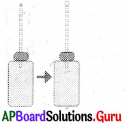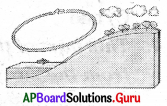AP State Syllabus 7th Class Science Bits 8th Lesson Air, Winds and Cyclones with Answers
Practice the AP 7th Class Science Bits with Answers Chapter 8 Air, Winds and Cyclones on a regular basis so that you can attempt exams with utmost confidence.
Choose the correct answer.
Question 1.
Air exerts
A) Cooling
B) Heating
C) Rain
D) Pressure
Answer:
D) Pressure
Question 2.
Air expands on
A) Cooling
B) Heating
C) On its own
D) None
Answer:
B) Heating
![]()
Question 3.
Hot air is
A) more dense
B) less dense
C) bad
D) none
Answer:
B) less dense
Question 4.
This part of the globe gets more heat from the sun
A) polar region
B) near the polar region
C) region close to equator
D) all the regions
Answer:
C) region close to equator
Question 5.
Tropical cyclones are like
A) Giant engines
B) Destructive army
C) Enemies
D) Friends
Answer:
A) Giant engines
Question 6.
Most cyclones tend to occur towards
A) Indian ocean
B) Pacific ocean
C) Arabian sea
D) Bay of Bengal
Answer:
D) Bay of Bengal
![]()
Question 7.
The other names of cyclone are
A) Typhoons
B) Hurricanes
C) Cyclones
D) All the above
Answer:
D) All the above
Question 8.
Cyclone watch is issued in advance of
A) 24 hours
B) 36 hours
C) 48 hours
D) 60 hours
Answer:
C) 48 hours
Question 9.
The instrument that measures wind speed is
A) Anemometer
B) Spherometer
C) Speedometer
D) Barometer
Answer:
A) Anemometer
Question 10.
In India cyclone usually occur in
A) January
B) April
C) May – June
D) December
Answer:
C) May – June
![]()
Question 11.
Air moves from
A) higher pressure to low
B) lower pressure to high
C) cool to hot
D) hot to cool
Answer:
A) higher pressure to low
Question 12.
The warm air moves to
A) downwards
B) upwards
C) no movement
D) all directions
Answer:
A) downwards
Question 13.
One of the following cools fast
A) sea water
B) land
C) river
D) all of these
Answer:
B) land
Question 14.
Uneven heating takes place on the surface of the ………
A) sea
B) hill
C) earth
D) river
Answer:
C) earth
![]()
Question 15.
……….. gets more heat from the sun.
A) Equator
B) Pole
C) Desert
D) Earth
Answer:
A) Equator
Question 16.
One of the following heats up fast
A) land
B) sea
C) fog
D) all of these
Answer:
A) land
Question 17.
Find out a cyclonic storm
A) Typhoon
B) Hurricane
C) Both A & B
D) Tornado
Answer:
C) Both A & B
Question 18.
On heating air gets
A) expands
B) less dense
C) occupies more space
D) all of these
Answer:
D) all of these
![]()
Question 19.
The differential heating of land and water by the sun leads to breeze.
A) land
B) sea
C) moon
D) land and sea
Answer:
D) land and sea
Question 20.
Monsoon winds start from
A) May
B) June
C) August
D) July
Answer:
B) June
Question 21.
Main effect of cyclone
A) heavy wind
B) heavy rain
C) tsunamies
D) heavy wind and rain
Answer:
D) heavy wind and rain
Question 22.
More cyclones tend to occur on the ……….. side of India.
A) north
B) south
C) east
D) west
Answer:
C) east
![]()
Question 23.
IMD provides information mainly about
A) Cyclones
B) Typhoons
C) Hurricanes
D) All of these
Answer:
D) All of these
Question 24.
………… plays an important role in the formation of cyclones
A) Wind speed
B) Humidity
C) Temperature
D) None of these
Answer:
A) Wind speed
Question 25.
Anemometer measures
A) Temperature
B) Pressure
C) Wind
D) All of these
Answer:
C) Wind
Question 26.
Through this experiment we can conclude that

A) Bottle is empty
B) Bottle is filled with air
C) Bottle is filled with water
D) Air is every where
Answer:
D) Air is every where
![]()
Question 27.
Through this experiment we can conclude that

A) Water expands on heating
B) Solids expands on heating
C) Air expands on heating
D) Cold air is lighter than hot air
Answer:
C) Air expands on heating
Question 28.
This figure tells us

A) hot air is lighter than cold air
B) cold air is lighter than hot air
C) air expands on heating
D) air exerts pressure
Answer:
A) hot air is lighter than cold air
Question 29.
It occurs during

A) daytime
B) night time
C) both A and B
D) none of these
Answer:
A) daytime
Question 30.
Tells us

A) Rainfall
B) Mist
C) Wind
D) Cyclone
Answer:
D) Cyclone
![]()
Question 31.
Wind moves from
A) higher pressure to low
B) lower pressure to high
C) cool to hot
D) hot to cool
Answer:
A) higher pressure to low
Question 32.
A gentle breeze blowing from the ocean towards the land is called
A) land breeze
B) see breeze
C) monsoon
D) cyclone
Answer:
B) see breeze
Question 33.
More cyclones tend to occur is
A) Arabian sea
B) Indian ocean
C) Bay of Bengal
D) None of these
Answer:
C) Bay of Bengal
Question 34.
We used this to study cyclones
A) Satellite
B) Radars
C) Both A & B
D) None of these
Answer:
C) Both A & B
![]()
Question 35.
In India cyclones usually occur in the month of
A) May & June
B) October & November
C) Both A & B
D) None of these
Answer:
C) Both A & B
Question 36.
“Cooperate and help your neighbours & friends”. It is a ……….
A) pre cyclone measure
B) post cyclone measure
C) pre tsunami measure
D) pre monsoon measure
Answer:
B) post cyclone measure
Question 37.
The following is a cyclonic strom
A) Typhoon
B) Hurricane
C) Both A & B
D) Tornado
Answer:
C) Both A & B
Question 38.
Which one plays an important role in the formation of cyclones?
A) Humidity
B) Temperature
C) Wind speed
D) None of these
Answer:
C) Wind speed
![]()
Question 39.
Which one of the following causes wind movements?
A) Uneven heating on the earth
B) Uneven rainfall on the earth
C) Uneven humidity in the atmosphere
D) The Sun
Answer:
A) Uneven heating on the earth
Question 40.
Factor contributing to the cyclone
A) Wind speed
B) Wind direction
C) Humidity
D) All of these
Answer:
D) All of these
Question 41.
When do we should make necessary arrangements to shift essential household goods domestic animals and vehicles?
A) After cyclone
B) After Tsunami
C) Before cyclone
D) Before monsoons
Answer:
C) Before cyclone
Question 42.
It is a ……….

A) Tsunami
B) Monsoon
C) Tornado
D) Cyclone
Answer:
D) Cyclone
![]()
Question 43.
Name of this aparatus

A) Raingauge
B) Speedometer
C) Thermometer
D) Stop watch
Answer:
B) Speedometer
Question 44.
Which of the following is a correct precaution to be followed during a cyclone?
A) Need not follow suggestions made by weather forecast
B) Blindly following neighbours’ suggestions
C) Switch off electrical mains
D) Need not consult emergency service providers
Answer:
C) Switch off electrical mains
Question 45.
Take a bucket with water.
Now immerse a bottle with a narrow mouth in the bucket till the bottle is filled with water, as shown here. Notice the air bubbles coming out of the bottle when water enters the bottle. Based on this, we can say that the aim of this experiment is to show that

A) Air expands on heating
B) Warm air rises up
C) Air has no mass
D) Air occupies space
Answer:
D) Air occupies space
Question 46.
Ramu collected 4 small paper cups, two strips of car board with dimensions 20 cm length and 2 cm breadth, gum, stapler, sketch pen and sharpened pencil. Using these materials, Ramu made the apparatus as shown here.

A) Windmill
B) Thermoscope
C) Anemometer
D) Barometer
Answer:
C) Anemometer
![]()
Question 47.
The following is an IMPORTANT safety measure one needs to take AFTER a cyclone has passed
A) Avoid contact with hanging, loose electrical wires
B) Avoid going inside a building and stay outdoors
C) Wear thick clothing made of wool
D) Cover the head with a hat and have plenty of fluids
Answer:
A) Avoid contact with hanging, loose electrical wires
Question 48.
Information from the following makes it possible to give cyclone warnings 24 hours in advance
A) Rain gauge and thermometer
B) Satellites and radars
C) Anemometer and barometer
D) Speedometer and hydrometer
Answer:
C) Anemometer and barometer